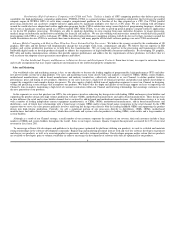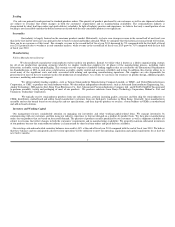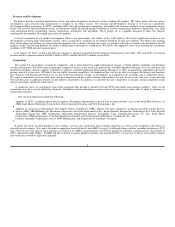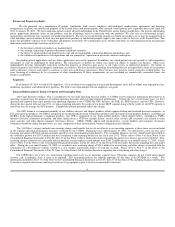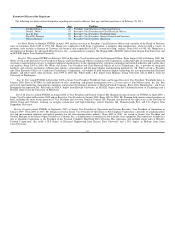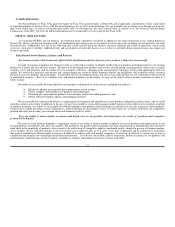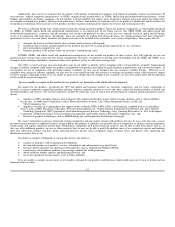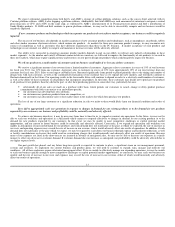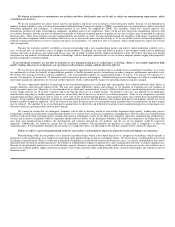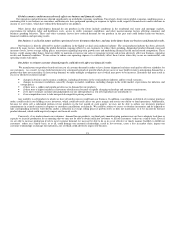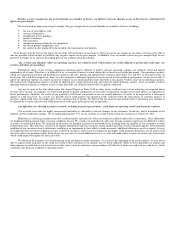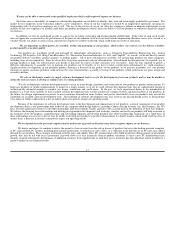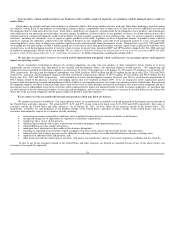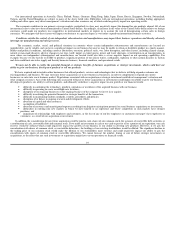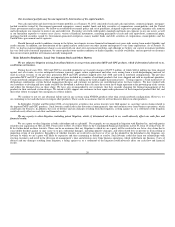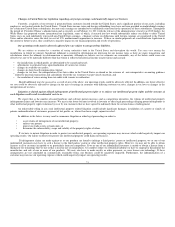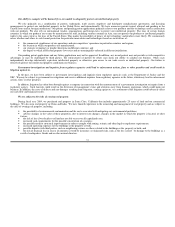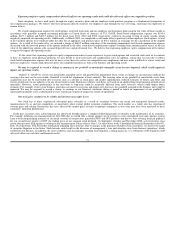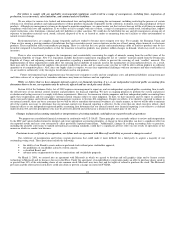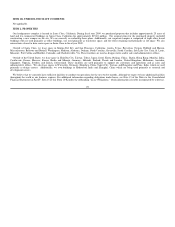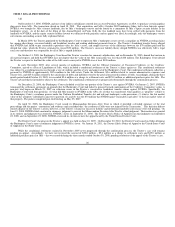NVIDIA 2011 Annual Report Download - page 18
Download and view the complete annual report
Please find page 18 of the 2011 NVIDIA annual report below. You can navigate through the pages in the report by either clicking on the pages listed below, or by using the keyword search tool below to find specific information within the annual report.
Because our gross margin for any period depends on a number of factors, our failure to forecast changes in any of these factors could adversely
affect our gross margin.
We are focused on improving our gross margin. Our gross margin for any period depends on a number of factors, including:
• the mix of our products sold;
• average selling prices;
• introduction of new products;
• product transitions;
• sales discounts;
• unexpected pricing actions by our competitors;
• the cost of product components; and
• the yield of wafers produced by the foundries that manufacture our products.
If we do not correctly forecast the impact of any of the relevant factors on our business, there may not be any actions we can take or we may not be able to
take any possible actions in time to counteract any negative impact on our gross margin. In addition, if we are unable to meet our gross margin target for any
period or the target set by analysts, the trading price of our common stock may decline.
Our revenue may fluctuate while our operating expenses are relatively fixed, which makes our results difficult to predict and could cause our
results to fall short of expectations.
Demand for many of our revenue components fluctuates and is difficult to predict, and our operating expenses are relatively fixed and largely
independent of revenue. Therefore, it is difficult for us to accurately forecast revenue and profits or losses in any particular period. Our operating expenses,
which are comprised of research and development expenses and sales, general and administrative expenses represented 33% and 38% of our total revenue for
fiscal years 2011 and 2010 respectively. Since we often recognize a substantial portion of our revenue in the last month of each quarter, we may not be able to
adjust our operating expenses in a timely manner in response to any unanticipated revenue shortfalls in any quarter. Further, some of our operating expenses,
like stock-based compensation expense, can only be adjusted over a longer period of time and cannot be reduced during a quarter. If we are unable to reduce
operating expenses quickly in response to any revenue shortfalls, our financial results will be negatively impacted.
Any one or more of the risks discussed in this Annual Report on Form 10-K or other factors could prevent us from achieving our expected future
revenue or net income. Accordingly, we believe that period-to-period comparisons of our results of operations should not be relied upon as an indication of
future performance. Similarly, the results of any quarterly or full fiscal year period are not necessarily indicative of results to be expected for a subsequent
quarter or a full fiscal year. As a result, it is possible that in some quarters our operating results could be below the expectations of securities analysts or
investors, which could cause the trading price of our common stock to decline. We believe that our quarterly and annual results of operations may continue to
be affected by a variety of factors that could harm our revenue, gross profit and results of operations.
Any difficulties in collecting accounts receivable, including from foreign customers, could harm our operating results and financial condition.
Our accounts receivable are highly concentrated and make us vulnerable to adverse changes in our customers’ businesses, and to downturns in the
industry and the worldwide economy. We recorded approximately 17% of our accounts receivable balance from two customers at January 30, 2011.
Difficulties in collecting accounts receivable could materially and adversely affect our financial condition and results of operations. These difficulties
are heightened during periods when economic conditions worsen. We continue to work directly with more foreign customers and it may be difficult to collect
accounts receivable from them. We maintain an allowance for doubtful accounts for estimated losses resulting from the inability of our customers to make
required payments. This allowance consists of an amount identified for specific customers and an amount based on overall estimated exposure. If the financial
condition of our customers were to deteriorate, resulting in an impairment in their ability to make payments, additional allowances may be required, we may
be required to defer revenue recognition on sales to affected customers, and we may be required to pay higher credit insurance premiums, any of which could
adversely affect our operating results. In the future, we may have to record additional reserves or write-offs and/or defer revenue on certain sales transactions
which could negatively impact our financial results.
We obtain credit insurance over the purchasing credit extended to certain customers. As a result of the tightening of the credit markets, we may not be
able to acquire credit insurance on the credit we extend to these customers or in amounts that we deem sufficient. While we have procedures to monitor and
limit exposure to credit risk on our accounts receivable, there can be no assurance such procedures will effectively limit our credit risk or avoid losses, which
could harm our financial condition or operating results.
16


